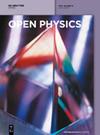低信噪比光子多普勒信号的弱拍频提取方法
IF 1.8
4区 物理与天体物理
Q2 PHYSICS, MULTIDISCIPLINARY
引用次数: 0
摘要
在短时傅里叶变换后的低信噪比光子多普勒信号的窗函数谱中,由于噪声谱的幅值超过了弱拍频率,因此无法通过提取每个窗的最大幅值谱频率来获得弱拍频率。在本文中,首先通过卡尔曼滤波器估计节拍频率值。然后,构建一个多重分析带通滤波器,以节拍频率估计值为频谱带中心,细化高噪声信号的频谱。这种技术通过去除干扰频谱带范围,只从窄带细化频谱中提取节拍频率。我们使用该技术处理来自微小高速飞行碎片爆炸实验的光子多普勒信号。经过数据处理后,受高频噪声影响严重的拍频值误差可降低 64.9%。低噪声信号的拍频值在速度解调后可精确到 106 Hz,相当于 0.775 m/s。该方法充分考虑了节拍频率特性的定位和保护。它在不改变信号幅度的情况下,使细化后的窄带频谱中的弱拍频更加明显。本文介绍了一种提取光子多普勒信号弱拍频的方法,或一种在测试环境中需要高精度拍频的信号优化算法。本文章由计算机程序翻译,如有差异,请以英文原文为准。
Weak beat frequency extraction method for photon Doppler signal with low signal-to-noise ratio
In the window function spectrum of the low signal-to-noise ratio photon Doppler signal after the short-time Fourier transform, the weak beat frequency cannot be obtained by extracting the maximum amplitude spectrum frequency of each window because the amplitude of the noise spectrum exceeds the weak beat frequency. In this article, the value of the beat frequency is first estimated by the Kalman filter. Then, a multiple analytical bandpass filter is constructed to refine the spectrum of the high noise signal with the value of the beat frequency estimate as the spectrum band center. This technique extracts only the beat frequencies from the narrowband refinement spectrum by removing the interference spectrum band range. We use this technique to process the photon Doppler signals from the tiny high-speed flying fragments explosion experiment. After data processing, the beat frequency value heavily affected by high-frequency noise can reduce the error by up to 64.9%. The beat frequency value of the low noise signal can be accurate to 106 Hz, equivalent to 0.775 m/s after velocity demodulation. This method fully considers the positioning and protection of the beat frequency characteristics. It makes weak beat frequencies more obvious in the refined narrowband spectrum without changing the signal amplitude. This article describes a method for extracting the weak beat frequency of the photon Doppler signal or a signal optimization algorithm for needing high-precision beat frequencies in a test environment.
求助全文
通过发布文献求助,成功后即可免费获取论文全文。
去求助
来源期刊

Open Physics
PHYSICS, MULTIDISCIPLINARY-
CiteScore
3.20
自引率
5.30%
发文量
82
审稿时长
18 weeks
期刊介绍:
Open Physics is a peer-reviewed, open access, electronic journal devoted to the publication of fundamental research results in all fields of physics. The journal provides the readers with free, instant, and permanent access to all content worldwide; and the authors with extensive promotion of published articles, long-time preservation, language-correction services, no space constraints and immediate publication. Our standard policy requires each paper to be reviewed by at least two Referees and the peer-review process is single-blind.
 求助内容:
求助内容: 应助结果提醒方式:
应助结果提醒方式:


